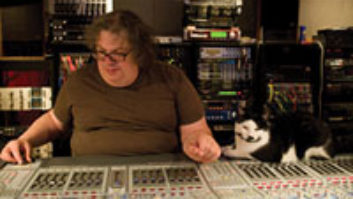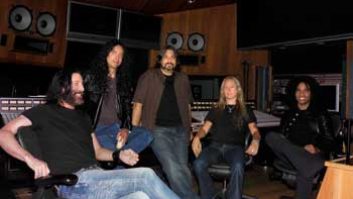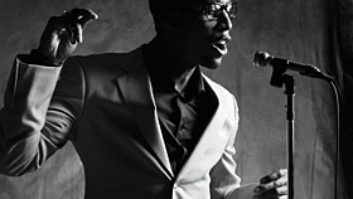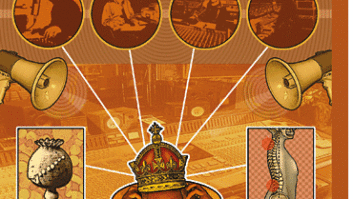For our annual look at vocal-recording techniques, we chose four
stylistically different recent CDs and talked with the engineers about
the gear and methods they used to capture the singers. This time
around, we looked in on album sessions with rock titan David Bowie,
up-and-coming chart-topper Avril Lavigne, the talented and
sophisticated singer/songwriter Duncan Sheik and the incomparable soul
vocal group Boyz II Men.
Tony Visconti
David Bowie’s Heathen
Engineer: Tony Visconti
The partnership between David Bowie and producer/engineer Tony
Visconti dates back to the late ’60s and encompasses so many of the
legendary singer’s greatest works, including Young Americans,
Low, Heroes, the magnificent live album Stage and
many others. Bowie’s latest is called Heathen, and many fans
agree that it is his strongest collection of songs in many years;
perhaps not coincidentally, it marks the first time Bowie and Visconti
have collaborated on a full album in more than two decades. If
anything, Bowie is an even better singer today than he was during the
earlier decade-plus he worked with Visconti. And both remain committed
to taking chances in the studio: Heathen is loaded with
brilliant and unusual instrumental and vocal touches; it’s quite a tour
de force all the way around.
“He’s truly a great singer,” Visconti says.“That
has never changed. During the Low, Heroes, Lodger and Scary
Monsters period, he would often write lyrics and sometimes melody
right on mic! And that writing session would be the master vocal take,
as well. He’d ask me to roll the tape, he’d sing two lines, then he’d
pause, work out another two lines and ask me to punch them in. At the
end of, say, an hour of this, he’d ask to double-track certain lines,
and voila! We’d have a lead vocal. I would often stand next to
him and sing backups to those vocals. In the end, it would sound so
incredibly rehearsed, but it wasn’t. Other artists I’ve worked with had
to try out this method when I told them about it, but it would backfire
— after 10 hours of nonproductive writing and singing. I guess
only Bowie can work this way. His mind is mercurial, and his vocal
chops are first-class!
“We did a bit of that on Heathen, although he worked
out most of his lyrics before he attempted a master vocal,”
Visconti continues.“The daunting thing was, sometimes he’d want
to change one line or word a month later and, hopefully, we could match
the levels and EQ so that it would sound seamless. Nonlinear digital
recording made this easier, but EQs and compression levels can easily
get nudged over the course of two months.”
Visconti says that the basic vocal chain on the album consisted of
Bowie’s own Manley Gold Reference Mic into an Avalon mic pre, into an
LA-3A compressor and a Focusrite Red EQ, then into an Apogee 8000 A/D
converter and a G4 Mac running Logic Audio. “I started recording
vocals on analog, as I did with all of the drums [16-track at 15 ips
with Dolby SR, or 30 ips with no noise reduction — I consider it
to be the ultimate tape format,” Visconti says, but the lock-up
became tedious, so we stayed in the digital realm — 24-bit,
44.1k]. On one song, ‘I Took a Trip on a Gemini
Spacecraft,’ I used a Shure SM57 to get a rockier sound, but I
later regretted that because the Manley spoiled me rotten. It’s such a
sweet mic, very musical in the midrange. The Manley mic vocals just
leapt out of the mixes, whilst the 57 needed lots of EQ, compression
and, ultimately, de-essing to get it above the mix.”
The CD was cut mostly at Allaire Studios, a gorgeous residential
facility on the grounds of a 1920s mountain estate two hours north of
Manhattan, and posted and mixed at Philip Glass’ Looking Glass Studios
in Manhattan. (For more on that studio, see last month’s “Coast
to Coast” section.) Because he both recorded and mixed the album,
Visconti looked toward the end result and conceptualized effects as he
went, rather than waited until the final mix to lay everything on. And
he was not above using some of his tried-and-true techniques on the
album, either.
“On some tracks, like ‘Sunday’ and ‘I Would
Be Your Slave,’ we decided to resurrect the ‘Heroes’
vocal sound that some of your readers might recall when I’ve described
it before,” Visconti says. “You need a big studio, and
Allaire’s room is huge and not treated — other than a few carpets
and tapestries judiciously placed on the floors and walls. The pitched
ceiling is about 35 feet high, and the floor is something like
25×40 feet. The way we did it, the main mic was augmented by two
more, placed about 12 feet and 30 feet from David. The two distant mics
were probably Neumann U87s but going through Drawmer noise gates. I
carefully adjusted the thresholds of the gates to open when David sang
above a certain volume. The mic at 12 feet would open when he sang
mezzoforte, and the mic at 30 feet would only open when he sang
fortissimo. Of course, the mic at 12 feet would be open then,
too. I put the distant mics in omni mode to catch more of the
reflections off of the walls and ceiling rather than David’s direct
voice.
“No other special effects were used during the recording.
David likes some reverb in his headphones when he sings. He’s very much
a two-take singer and comping is a breeze because of that. If he
doesn’t get it entirely in two takes, he will punch in the necessary
line, word or even syllable. He is so slick and confident; plus, his
voice is possibly the most sonorous voice I’ve ever recorded, rich in
overtones and sheer power!He sings bang-on in-tune, so Antares is
almost wasted on him. But I must confess to fixing a little
unintentional wiggle during the mixes because he wasn’t available to
fix it.
“On the mix, I use the usual effects on his vocal,” he
continues.“That is, some slapback when called for, some reverb
— usually a rich Lexicon program — and the occasional
pitch-shifted delay to make an almost automatic double-tracking [ADT]
effect. I’ve been using these effects on his vocals as long as I’ve
been working with him, since 1968.
“Slapback, since Elvis’ day, gives a menacing sound, like a
pagan god standing on a monolith in a valley. Flanging and chorusing
seem to impart an air of mystery and a kind of druggy feeling for the
lyrics — okay, I admit to surviving the ’60s and ’70s, and none
of my children are mutants!Reverb just makes a vocal sound powerful and
authoritative when the vocal is loud and confident. Reverb on a light
or whispered vocal just sounds sexy. Then-there are some really freaky
things you can do with pitch shifting, octave dividing, but they are
for very specific uses. I am always guided by the lyric and the emotion
of the song and singer. And I try to use special effects in an emphatic
context, not just for the sake of making a weird sound.”
Scott Spock
Photo: Richard Elen
Avril Lavigne’s Let Go
Engineer: Scott Spock
When the red-hot songwriting/production team The Matrix —
that’s Lauren Christy, Graham Edwards and Scott Spock — was first
approached about contributing a song to the debut album of an unknown
Canadian teenager named Avril Lavigne, “Initially, we were told
she was going to be kind of like Faith Hill,” says Spock with a
chuckle. “She came in and sat on the couch, and we played her
this song we’d written that was along the lines of a Faith Hill track,
and she was not happy. She said, ‘I don’t want to do this;
I want to rock!’ We didn’t know that she was this skater,
punky type of girl. So we said, ‘Okay, let’s come up with a
premise, then you come back tomorrow and we’ll write a song. She came
in the next day and we wrote ‘Complicated.’ Boom!
L.A. [Antonio “L.A.” Reid, president of Arista Records]
heard it and said, ‘Yeah, that’s the direction,’ and he
sent her back to work with us for a month.”
The fruit of their labor was six songs, five of which appear on
Lavigne’s multi-Platinum debut album Let Go, including the hits
“Complicated” and “Sk8er Boi,” and the
projected next single, the ballad “I’m With You.” For The
Matrix, it’s just the latest triumph in a career that’s shooting into a
higher orbit every day. Other top artists they’ve worked with include
Christina Aguilera, the Backstreet Boys, Ricky Martin, Nick Carter and
Liz Phair. All three Matrix members helped write and sing on the tunes
they did with Lavigne, and Spock was the principal engineer. Tom
Lord-Alge mixed their songs, though Spock’s less-polished mix of
“Complicated” has also received significant airplay.
Whenever possible, The Matrix like to eschew conventional recording
studios in favor of working in rented houses, where they set up their
Pro Tools rigs (they have four) and synths. Their work with Lavigne
took place in a comfortable house — dubbed Decoy Studios —
in an L.A. suburb known as Valley Village. “It works out
great,” Spock says, “because vocalists come in and they’re
very relaxed. They don’t even realize that when they get on the mic,
it’s probably going to be on the record. With Avril, I think she
thought she was cutting the demo of a song. The comfort level is very
high working this way, and she’s not standing in a $2,500-a-day studio
and thinking, ‘Oh, my God, there’s the engineer and this
million-dollar board, and I’ve gotta sing this right ’cause it’s going
on the record!’ She came in, she was really relaxed, and she
nailed it. ‘Okay, Avril, that sounds good.’ ‘It does?
Cool!’”
Though he generally likes to do as much work as he can within his
Pro Tools system and using native plug-ins — including
compression and EQ — Spock also admits to a fondness for some
vintage gear. “I’m a big advocate of recording to Neve
1272s,” he says. “All of the guitars on
‘Complicated’ are through those. When I did the vocals, I
was trying a Manley Voxbox at the time, and I really fell in love with
it and wanted to use it on a few things. But I felt Avril sounded best
through the 1272 and the Distressor. There was something in her voice
that was malleable with the track going that way.” Spock adds,
“I’m also heavily into Apogee AD8000 [A/D converters]. They add
so much depth to a recording. To me, it’s like night and
day.”
Lavigne was set up in a wood-paneled room that had padding on three
of the four walls and sang complete takes against the largely finished
instrumental tracks through a Neumann U87. She generally sang five or
six takes of each song, “and probably 90 percent of what was
finally used came from the first or second takes,” Spock says.
The Matrix contributed some backing vocals, though more often than not,
the shimmering blend is dominated by Lavigne herself — or so it
seems.
“She’s such a talent,” Spock says. “Sometimes you
need to really layer things to make someone sound good, but when you
work with Avril, who has this amazing voice, if you want to thicken it
out in the chorus, what I usually do is group the backgrounds together
and EQ the hell out of them to exactly that one frequency that will add
a little depth to the lead vocal without getting in the way, so you
feel it but don’t hear it. There’s maybe three-part harmony on the
chorus, but when you listen to it, it just sounds like her. I recorded
Lauren [Christy] in the background in places, and there might be Graham
[Edwards] and myself on a lower part, but heavily EQ’d. I took the
group and used Filterbank — you dial in whatever frequency you
want, so I EQ it really tight, so what I’m doing is pulling out
specific frequencies that Avril has and just building in bits of low
end and bits of high midrange to get the depth that I need in the
vocals.”
Spock concludes, “The more talent somebody has, the easier
they are to work with usually, especially singers. And the less
talented they are, the more insecure they are. ‘The mics aren’t
right.’ ‘The headphones sound weird.’ You get a lot
of that from insecure singers. That’s something you have to deal with
being a producer. And, fortunately, I didn’t have to with Avril. She
was really great, really enthusiastic.”
Michael Tudor
Duncan Sheik’s Daylight
Engineer: Michael Tudor
Duncan Sheik is a difficult artist to classify. The New York-based
singer/songwriter specializes in an elegant, intelligent, introspective
pop that straddles folk, rock and even alternative styles, sometimes
all within the same song. His aesthetic was no doubt affected by his
early ’90s work with producer Rupert Hine. Sheik’s newest album,
Daylight, finds him working with producer Patrick Leonard, and
that turns out to be a good match, too; he’s retained the tasteful rock
backings and occasional lush orchestrations but added all sorts of
interesting sonic and electronic touches. Sheik’s vocals — smooth
but with a hint of sandpaper in places — are always out front;
Leonard understands that Sheik’s singing carries the album and defines
his persona. The thoughtful and imaginative final mix was by veteran
producer/engineer Kevin Killen, so it was quite a team effort all
around.
“Duncan is an artist who really has a very thorough sense of
production compared to most other artists I’ve worked with,” says
Michael Tudor, who engineered the exquisite-sounding Daylight
album and is perhaps best known for his radio remixes of the Moby hits
“Southside” and “We Are All Made of Stars.”
“He has recording techniques that he likes and a good aesthetic
for gear and so on. So working with him is really a collaborative
thing, because he’ll have ideas about what microphones or preamps he
wants to use. My preference is generally to get the vocal through a
Neve pre; I’m not even picky about what it is — something old, I
guess. Duncan likes to use an 1176 for compression, and then normally,
I’ll throw some more compression on monitoring so he can have in his
cans a real in-his-face kind of sound, as opposed to that sort of
far-away sound that you sometimes get in a vocal booth, which is kind
of distracting when you’re really trying to throw yourself into a vocal
performance.”
The vocals for Daylight were cut in a few different studios,
beginning at Capitol Studio A in Hollywood, where the basics were
recorded. “We did some scratch vocals that turned into keepers
there,” says Tudor, who is based in New York and co-owns TMF
Studios near Union Square. “Initially, we had him set up in a
large iso booth with his acoustic guitar, some amps and a vocal mic so
he could play and sing along while the band did their thing. But then
when it was time to do a vocal overdub, he wanted to go out into the
main room, which is really big — something like 60×60 with a
40- or 50-foot ceiling — acoustically, it’s a beautifully
designed room. I’m very loose about experimenting with things, so we
set up a mic right in the middle of the room, and, vibewise, it was
just perfect. You didn’t even pick up that much room tone even though
it’s this massive space; it was nice and elegant and not over-the-top.
At that point, we were using his mic, which is this Mojave Audio tube
mic that Dave Royer designed. It’s based on a U47, but it looks kind of
like a C-12. So that was the mic we used for most of the vocals. Some
of the vocals were also recorded on a Telefunken 251, which I
understand is a somewhat interesting choice because it’s sort of picky
about what voices it likes. A U47 is a little more forgiving; you can
put any voice into that microphone. But Duncan’s voice really showed
off well with that microphone [the Telefunken], and he really liked
singing through that.”
The album was tracked to 2-inch Studer. “But we had Logic
Audio in sync the whole time,” Tudor says. “And after
basics, we transferred the analog tracks into Logic and overdubbed
against that.”
After the Capitol sessions, the action moved to Leonard’s
now-defunct Johnny Yuma studio in Santa Monica, Calif., to Cello (where
Leonard now has a room) and to Sheik’s own personal studio, which Tudor
says “is an excellent recording space, with a nice analog Calrec
console and some other nice equipment. It’s a really great environment
to work in.” Tudor says that Sheik is working on vocals at home;
he favors the Mojave mic through a Telefunken V72 preamp and the 1176
compressor.
“Usually,” Tudor says, “Duncan’s lead vocal parts
were sessions of their own, because in a lot of ways, it’s the most
important element in the track, and singing it is not just a matter of
singing it. He has to come up with a concept for the performance and
the delivery and the tone and all that. He likes to perform the song
all the way through, though the finished vocal might be big chunks from
maybe three different takes.
“With him, the vocal usually solidifies itself over a few
takes. Generally, we’ll put the song up, get some levels, get him
situated with the vibe. I always spend a lot of time trying to make the
singer real comfortable so that they’re in a good place mentally. Then
he’ll do a couple of takes just to warm up and get a sense of the
thing. Four or five takes into it, he starts to deliver some really
great performances. And they’ll change from take to take, as they
should, ultimately, because it’s about being in the moment of the song.
So then the comping becomes a performance issue more than anything
else. You’re looking for the most powerful and appropriate
interpretation of a given part of a song.
“The important thing with singers is, you want to give them a
sense that they’re there in the studio with you to explore and express
themselves and that it’s going to come from them rather than from me or
anyone else telling them what to do.”
Boyz II Men’s Full Circle
Engineer: James Porte
James Porte is young enough that he idolized Boyz II Men years
before he had a chance to work with them. “I loved that first
album [Cooleyhighharmony],” he says. “I remember
driving around in my Isuzu Impulse playing the Boyz II Men cassette
really loud when I was in high school. So it was cool to get to work
with them now — knowing their legend — and getting to hear
what they can do in the studio.”
Born in Liberia but raised mostly in Tennessee (where he attended
Middle Tennessee State’s excellent recording program), Porte moved to
New York City a few years ago and landed a job as a manager at the Hit
Factory and picked up some engineering work along the way. He’s done
remix work with The Trackmasters and worked with a number of artists on
his own, but the eight tracks (out of 14) he engineered on Boyz II
Men’s latest, Full Circle, are probably his best and
highest-profile work to date. When we spoke, he had just begun work in
Miami with Lauryn Hill.
The first surprise about Boyz II Men, who are certainly in the
pantheon of great vocal ensembles, is that they record individually
rather than as a group. “They never sang together,” says
Porte, who tracked their vocals in two different rooms at the Hit
Factory: studios 1 and 4, each of which is equipped with SSL 9000 J
consoles. “We did everything separately. They start off with one
guy going in and singing the melody. The next guy will come in —
it’s almost like it’s tag team — and do the harmony or another
part. Or somebody may do two parts when they’re in there. But it’s
usually not something they’ve rehearsed. They know their voices, and
they know exactly what to do. It was very relaxed. They wouldn’t even
be sitting in the studio waiting and listening to what the other person
was doing. They’d be recording in another room or just waiting for
their turn. ‘Okay, let me hear what he just did. Cool. Let’s
go!’ And they’d go in and be on it right away. It was
amazing.”
Porte says that all four of the Boyz — Wanya Morris, Nathan
Morris, Shawn Stockman and Michael McCary — are “very
open-minded, and they’re into the latest technology, as well as the
old-school technology. They were totally into trying different
microphones. If it was a more aggressive song, they wanted to use an
edgier microphone. If it was a pretty ballad, they wanted to use
something that had some smoothness to it.
“What we did was try to find a mic that covered the dynamic
range and frequency response of pretty much everyone,” Porte
continues, “and what we found worked really for us was the
Neumann M149 because it covered the bass range and Shawn on the pretty
top-end harmony. It’s a really warm mic; it adds a nice body to the
voice. Plus, it has enough air on the top end that it’s a cool sound.
We also used a vintage C-12, which has a lot of top end but not as
bright as the [Sony] C880G, which we also tried out. That was actually
used on the Babyface song [“The Color of Love”], because it
works well on that more pop style because it’s very open and
transparent. But it wasn’t as good for the edgier stuff we were doing.
The C-12 was used mostly on the more laid-back or lush
songs.”
Porte tracked the Boyz to a 48-channel Pro Tools setup, “and I
had it hooked up to an Aardvark Aardsync to try to enhance the clocking
of the whole system. Whenever possible, we tried to use the Apogee
AD8000 converters. The two preamps we used the most were the Avalon M2
dual-channel and a Martech. The Martech is great for anything —
clean and transparent, but also with some warmth.”
The rich, creamy stacks of background vocals proved to be the most
challenging element of the project for Porte. On several songs, there
are four tracks of each backing vocal part, and one — “I’ll
Show You” — has six tracks of each harmony. “We did
six parts, six stacks, and the harmonies are so intricate on that song
it almost sounds like a Take 6 record,” Porte says. “The
vocal producer on that one, J. Moss, was a real stickler; we did that
song for three days. But it’s got 24 tracks of backgrounds and then
leads on top of that — probably 36 tracks of vocals. It was
grueling.
“But the thing with them is that they blend so well with each
other, it doesn’t sound like that many tracks. Sometimes it sounds like
one person, it’s so thick and so tight. At the same time, they make
everything they do their own. If Shawn sings something, he makes it
Shawn. If Nate sings something, he makes it Nate, and so on.”
Because he was not going to be mixing the project, Porte didn’t have
to think too much about effects on the vocals, but he did have his hand
in a couple of interesting sonic touches. He reveals that on
“Roll Wit Me,” the robotic voice was achieved using the Pro
Tools AutoTune function: “Then, when it came time to mix, they
used the AutoTune mixed with another effect to be a little less
clichéd and to create something a little different, because that
whole AutoTune sound is getting a little played out.” And the
telephone vocal sound on “I’m Okay, You’re Okay” came from
a Q10 plug-in. “The Q10 is a little dark, so you have to brighten
it up a little bit,” Porte says. “As with anything, you
have to tweak until you get the best sound for that song.”






